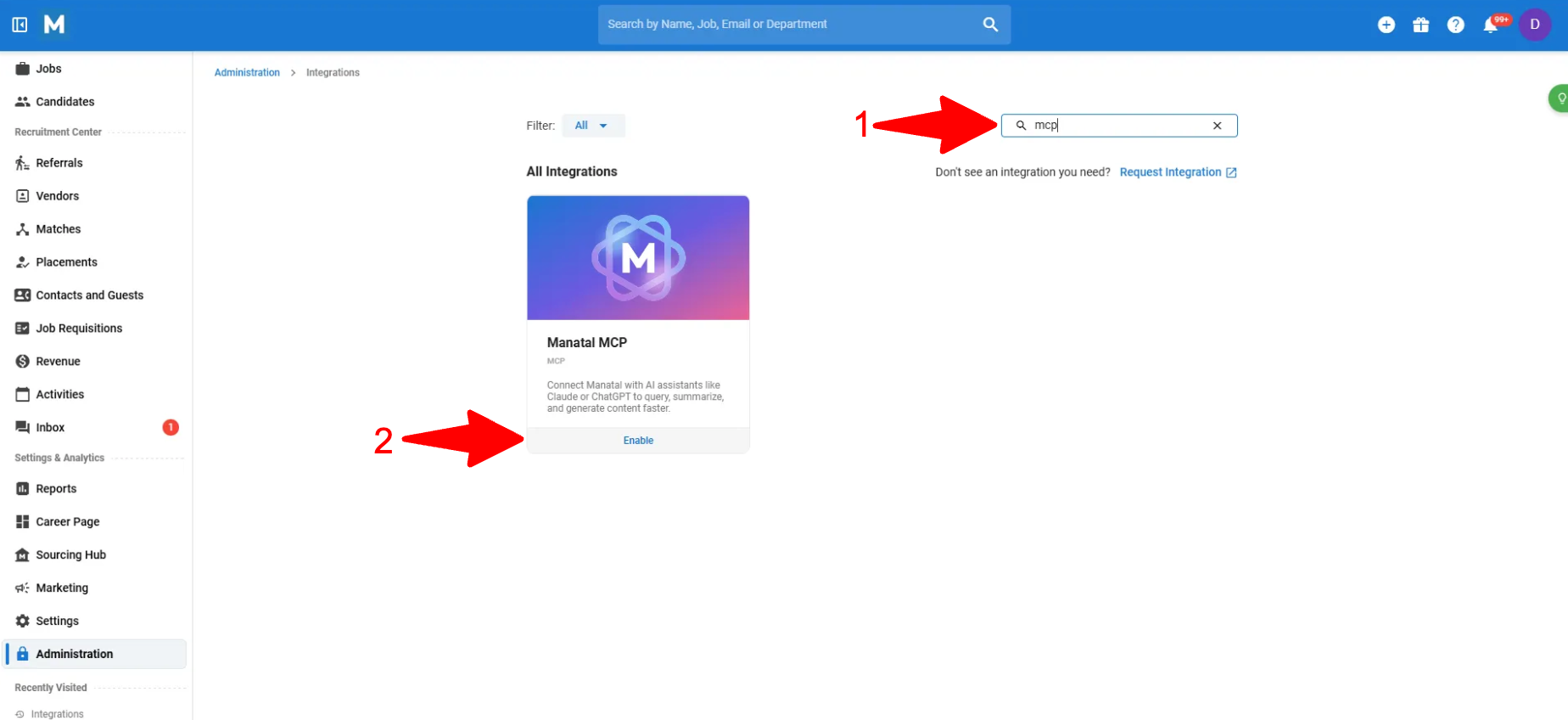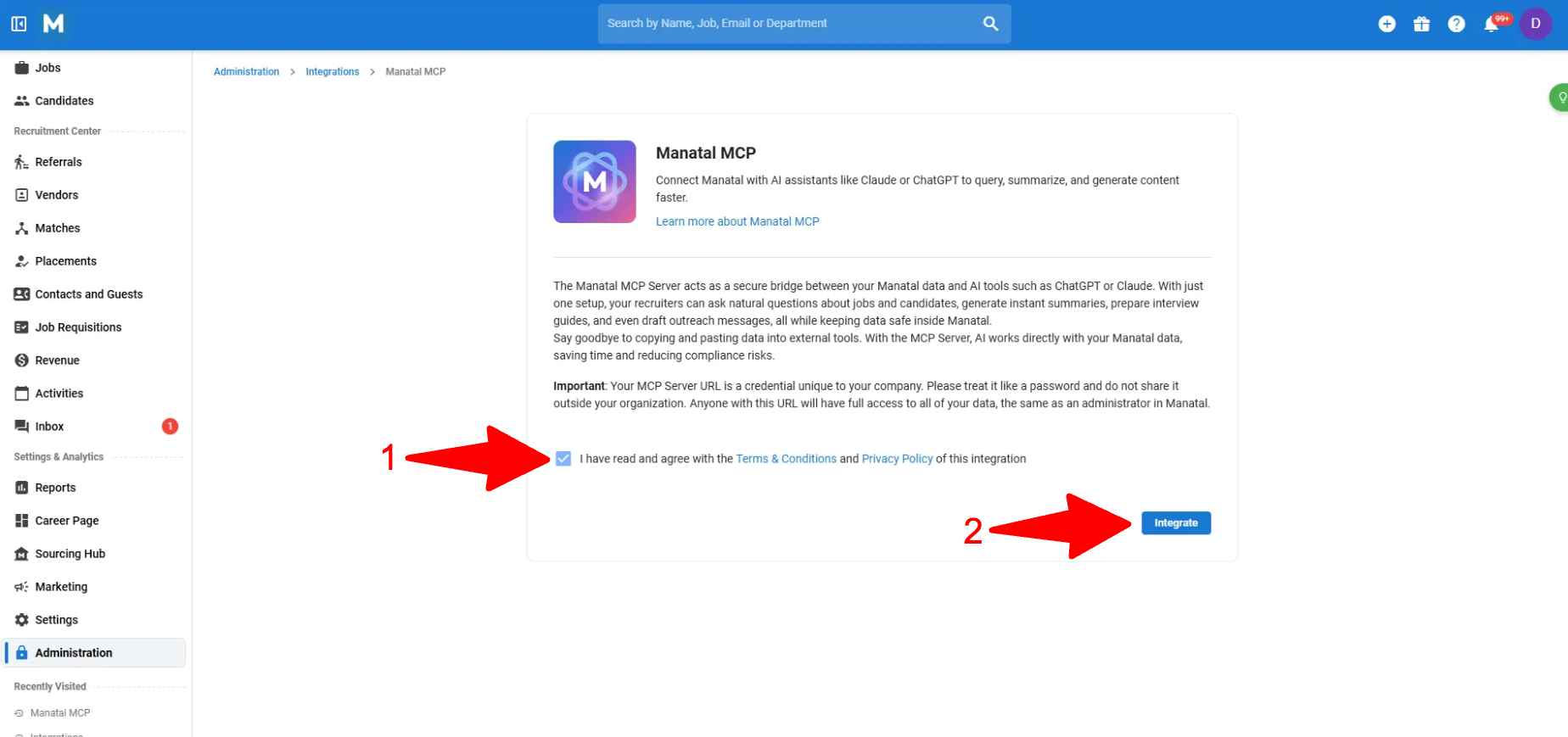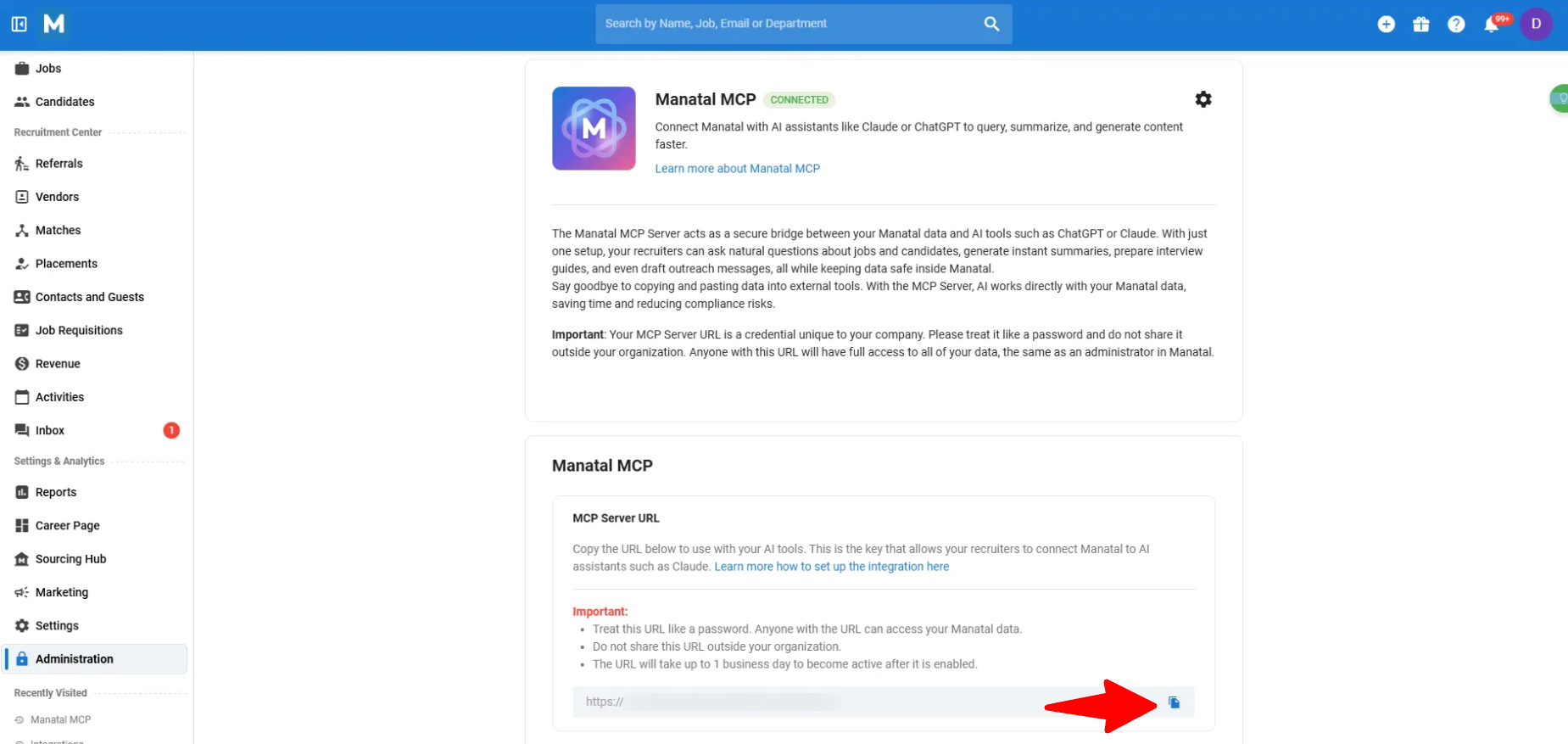Manatal MCP Server Overview
- Core features are available, but some advanced capabilities are still in development.
- The user experience may differ slightly across MCP clients (e.g., Claude vs. ChatGPT).
Connect your favorite AI tools to Manatal with our MCP Server. This allows your AI assistants to safely search, create, and manage your ATS data without constant tab-hopping.
What is MCP?
Model Context Protocol (MCP) is an open standard that connects AI applications and tools to external platforms like Manatal. With MCP, AI applications like ChatGPT and Claude can connect to data sources, tools, and workflows, allowing them to access additional information and perform tasks.
What is the Manatal MCP Server?
The Manatal MCP Server is our integration that directly connects with your AI tools to perform tasks like searching for candidates and jobs, creating notes, and managing matches. Any MCP-compliant client can connect to and use these capabilities, subject to your account's permissions.
Why use the Manatal MCP Server?
- Easy Setup: Connect with a simple URL authentication—no complex installation is required.
- Work from One Place: Ask your assistant to search, create, match, or add notes directly in Manatal.
- Faster Outcomes: Condense multi-step tasks into a single, natural-language request.
Who is it for?
- Recruiters: Ask for shortlists, summarize candidate profiles, and get suggested interview questions.
- Teams using AI copilots (like Claude or ChatGPT) for increased productivity.
- Developers and Partners: Build custom assistants or workflows that incorporate Manatal data.
What can you do with it?
- Candidates: Add new candidates, location, or status, and view full profiles.
- Jobs: Add new jobs, search or filter open roles, and view job details and pipelines.
- Organizations: Add organization (company/client) records and search for existing ones.
- Matches: Create matches between candidates and jobs, and search existing matches to review fit.
- Contacts: Search for contacts (e.g., hiring managers, referrers) to add context to your workflows.
- Notes: Add notes to candidates or jobs and view existing notes to keep collaboration in one place.
Getting Started
- Step 1: Connect to the Manatal MCP Server
- Step 2: See supported tools and common use cases
Step 1: Connecting to the Manatal MCP Server
Prerequisites:
- An active Manatal Enterprise Plus Plan subscription.
- Admin user permissions in Manatal to set up the integration.
- A compatible MCP client like Claude or ChatGPT.
This guide walks you through connecting your AI tools to Manatal using the Model Context Protocol (MCP).
You can connect to the Manatal MCP Server through the Integration Marketplace as shown below.
Supported Clients
Our MCP Server is designed to work with MCP-supported clients. However, we only verify and actively test the clients listed below. Other clients may work, but are not officially tested or supported.
Currently, the MCP Server is supported on the following AI tools:
- Claude.ai (Recommended for the best experience)
- ChatGPT (Note: Support is still in an experimental phase from the provider)
- Gemini CLI (For more technical users)
- Other MCP-supported clients (May be compatible, but we have not verified their behavior with our MCP Server)
Retrieving your MCP Server URL
-
Head to the following page. Alternatively, click on "Administration" from your side menu and open the "Integrations" category.


-
Search for "Manatal MCP", and click “Enable” on the card.

-
Review the integration details and disclaimers, accept the terms and conditions, and click “Integrate”.

-
You will now receive your MCP Server URL. Simply copy this URL to connect your AI tools.
Your MCP Server URL is a credential unique to your company. Treat it like a password and do not share it outside your organization. Anyone with this URL will have the same administrative access to your Manatal data as an Admin user.

Connect to Your AI Tool
Claude
A Claude Pro Plan (or higher) is required to add MCP connectors.
- Navigate to "Settings" in your Claude account.
- Click on the “Connectors” section in the left-side panel.
- Locate and click “Add custom connector”.
- Paste the MCP Server URL from Manatal, give the connector a name (e.g., "Manatal ATS"), and click “Add”.
- You can now access your Manatal database and tools inside Claude.
ChatGPT
- A ChatGPT Plus Plan (or higher) is required to add MCP connectors.
Accessing custom MCP Servers (like Manatal’s) in ChatGPT requires you to be in Developer Mode.
- Navigate to "Settings" in your ChatGPT account.
- Click on the “Apps & Connectors” section in the left-side panel.
- Scroll down and click on “Advanced settings”.
- Enable “Developer mode”.
- Navigate back to “Apps & Connectors” and click “Create” in the top right.
- Give the connector a name (e.g., "Manatal ATS") and paste your MCP Server URL from Manatal.
- For the “Authentication” option, select “No authentication,” check the box “I understand and want to continue” and click “Create”.
- In a chat, click on the + icon in the text field and select "More" and "Manatal ATS". You can now access your Manatal database and tools inside ChatGPT.
Gemini CLI
-
-
Open your computer's Terminal (Mac/Linux) or Command Prompt (Windows).
-
Type the following command and press Enter:
npm install -g @google/gemini-cli
NoteThis method requires that you have Node.js (https://nodejs.org/en/download/) installed on your computer first. If you don't have it, please install it before proceeding.
-
-
- Option 1 (Recommended): Log in with your Google account.
- Option 2: Use a Gemini API Key.
- Option 3: Use Google Cloud's Vertex AI.
-
Connect to your Manatal MCP Server
-
Find the
settings.jsonfile. It's usually located in a hidden folder named.geminiin your user's main directory. -
Open the
settings.jsonfile with a text editor (like Notepad, VS Code, or Sublime Text). -
Add the following section to the file. Make sure to replace the placeholder URL with your actual Manatal MCP Server URL:
{ "mcpServers": { "Manatal MCP": { "httpUrl": "<YOUR_MANATAL_MCP_SERVER_URL_HERE>" } } }ImportantReplace <YOUR_MANATAL_MCP_SERVER_URL_HERE> with the unique URL you received from Manatal.
-
Usage and Rate Limits
- Standard API rate limits apply to the Manatal MCP Server: 100 requests per minute.
Step 2: Supported Tools and Example Use Cases
The Manatal MCP Server provides the following MCP tools. AI assistants use these tools to create, search, and manage content in your Manatal ATS. You can find a complete breakdown of the inputs and data structures for these interactions in this guide.
- Most MCP clients, like Claude, ask you to manually approve each action before it runs. We strongly recommend keeping this setting enabled and always reviewing the details of a tool call before execution.
| Tool / Action Name | Technical Name | What It Does | Example Request |
|---|---|---|---|
| Search Candidates | candidates_list | Find and filter candidates by skills, experience, education, or location | "Show me all candidates who work at Google" |
| View Candidate Profile | candidates_read | See complete details for a specific candidate | "Get the full profile details for candidate ID 123" |
| View Candidate Education | candidates_educations_list | See a candidate's educational background and qualifications | "Show me the education history for candidate ID 123" |
| View Candidate Work History | candidates_experiences_list | See a candidate's previous jobs and experience | "Show me the work experience for candidate ID 123" |
| Add New Candidate | candidates_create | Add a new person to your candidate database | "Create a new candidate profile for John Smith with email john@example.com" |
| Add Candidate Education | candidates_educations_create | Record degrees, certifications, and schooling for a candidate | "Add a Master's degree in Computer Science from MIT for candidate ID 123" |
| Add Candidate Work History | candidates_experiences_create | Record employment history and positions for a candidate | "Add a Software Engineer position at Google for candidate ID 123" |
| View Candidate Notes | candidates_notes_list | Read all notes and comments about a candidate | "Show me all notes for candidate ID 123" |
| Add Candidate Notes | candidates_notes_create | Write observations, interview feedback, or reminders about a candidate | "Add a note 'Great communication skills' for candidate ID 123" |
| Search Contacts | contacts_list | Find people at client companies | "Show me all contacts at Microsoft" |
| View Contact Notes | contacts_notes_list | Read notes about your client contacts | "Show me all notes for contact ID 456" |
| Add Contact Notes | contacts_notes_create | Record conversations or reminders about client contacts | "Add a note 'Discussed partnership opportunities' for contact ID 456" |
| Search Jobs | jobs_list | Find open positions by role, status, or company | "Show me all active Software Engineer positions" |
| Create Job Opening | jobs_create | Add a new position you're looking to fill | "Create a new job opening for Senior Product Manager with remote work option" |
| View Job Details | jobs_read | See all information about a specific position | "Get the details for job ID 789" |
| View Job Notes | jobs_notes_list | Read notes and updates about a job opening | "Show me all notes for job ID 789" |
| Add Job Notes | jobs_notes_create | Record updates, requirements, or hiring progress | "Add a note 'Need to expedite hiring' for job ID 789" |
| View Candidate Matches | matches_list | See which candidates have been matched to which jobs and their progress | "Show me all candidate-job matches from the interview stage" |
| Match Candidate to Job | matches_create | Connect a candidate with a job opening | "Match candidate ID 123 with job ID 789" |
| Search Organizations | organizations_list | Find client companies in your database | "Show me all organizations in the technology industry" |
| Add Organization | organizations_create | Add a new client company to your system | "Create a new organization profile for Acme Corp" |
| View Organization Notes | organizations_notes_list | Read notes about a client company | "Show me all notes for organization ID 321" |
| Add Organization Notes | organizations_notes_create | Record information about client relationships and interactions | "Add a note 'Key client in healthcare sector' for organization ID 321" |
Common Use Cases (Tool Chaining Examples)
These tools work seamlessly together through prompts, and their real power comes from combining them. With a single prompt, you can search for top candidates, summarize them, match them to a job, and add a note. Understanding these tools will help you craft efficient prompts that tackle complex tasks by combining multiple tools.
The following use-cases are meant for guidance for what is possible to leverage. Do note that you would need to have available data in your Manatal account (i.e. existing jobs, clients, notes, etc.) to perform some of the actions below.
Use Case 1: Interview Preparation from Candidate Profile & Job Description
Scenario: You have an upcoming interview and need to prepare relevant questions and talking points based on the candidate's background and the job requirements.
How to Use (Example Prompt):
I'm interviewing Daniel Wellington (daniel.wellington@email.com) tomorrow for our Senior Product Manager position for Acme Corp. Do the following:
1. Find the profile using their email address
2. Pull their complete candidate information
3. Check any notes our team has added about them
4. Find our "Senior Product Manager" job opening at Manatal
5. Get the complete job description and requirements
6. Review any notes about this role
Then synthesize all this information to create a one-page prep note (5 questions max) containing tailored interview questions that align their experience with our role requirements.
What You'll Get:
- Tailored interview questions that align the candidate's experience with job requirements.
- Key areas to probe during the conversation.
- Talking points about how their background fits the role.
- Specific examples from their history to discuss.
Use Case 2: Executive Summary Email for Hiring Manager
Scenario: Your hiring manager needs a quick overview of top candidates before making interview decisions.
How to Use (Example Prompt):
For the candidates selected below, prepare an executive summary for our client by doing the following:
1. Retrieve the full profiles of the following candidates:
- Daniel Wellington (daniel.wellington@email.com)
- Emma Johnson (emma.johnson@email.com)
- Martina Lopez (martina.lopez@email.com)
2. Then create a professional executive summary email with the following template:
Hi John,
Please find below the top candidates for your review. Thank you.
Candidate: (Candidate Display Name) (Candidate Location)
Candidate Highlights: (Summary of Candidate 2-3 Lines)
Work Experience:
- (Position 1) - (Company Name) - (Date Range) - (Tenure)
- (Position 2) - (Company Name) - (Date Range) - (Tenure)
What You'll Get:
- Professional, concise email ready to send.
- Key highlights of each candidate's strengths.
- Relevant experience and qualifications summarized.
Use Case 3: Comprehensive Candidate Pipeline Review
Scenario: You need to update stakeholders on the status of all active candidates across multiple positions.
How to Use (Example Prompt):
Create a pipeline status report for the Senior Data Scientist position at Acme Corp. Do the following:
1. Find the "Senior Data Scientist" job at "Acme Corp"
2. Get the job details and any notes about hiring progress
3. Find all candidates currently matched to this job
4. For each matched candidate, review their notes for status updates
Then compile a progress report with the following:
- Job overview: position title, status, and urgency
- Top 3 candidates: name, current stage, and brief status for each
- Next steps: what needs to happen to move candidates forward
What You'll Get:
- Overview of all candidates in your pipeline.
- Status of each candidate by hiring stage.
- Identification of any bottlenecks.
- Suggested next actions.
- Ready-to-share progress report.
Use Case 4: Client Relationship Management
Scenario: You're preparing for a call with a key client organization and need context on your relationship history and current engagements.
How to Use (Example Prompt):
I have a meeting with Acme Corp tomorrow. Help me prepare by doing the following:
1. Find "Acme Corp" in our client database
2. Find all contacts at "Acme Corp"
3. Find all active jobs at "Acme Corp"
3. Review all notes about our interactions with them
Then create a meeting brief with:
- Company overview: key details from our notes
- Key contacts: names and roles (max 3 people)
- Current jobs: position titles and status (max 3 positions)
- Talking points: 3 key items to discuss in the meeting
What You'll Get:
- Complete relationship history.
- Summary of previous conversations and commitments.
- Overview of current hiring needs.
- Talking points for your meeting.
- Context on key contacts and their preferences.
Use Case 5: Rapid Candidate Sourcing and Matching
Scenario: A new urgent job opening comes in and you need to quickly identify and match suitable candidates from your existing database.
How to Use (Example Prompt):
We just opened a Full Stack Developer role at Acme Corp. Help me find matches by doing the following:
1. Get the complete job details for the "Full Stack Developer" role at "Acme Corp"
2. Search for candidates with:
- Current location in "San Francisco"
- "Developer" in their current position
- Limit to 20 results
3. For the candidates found:
- Get their complete profiles & identify the top 3 candidates
- Match them to the job
4. For each matched candidate, add a note explaining:
"Matched to "Full Stack Developer" role. Fit reason: [brief explanation why]"
Then provide:
- Top 3 matched candidates with names and current companies
- Brief reason why each is a good fit (2-3 sentences)
- Suggested next step for outreach
What You'll Get:
- Ranked list of best-fit candidates.
- Rationale for each match.
- Gaps or concerns to address.
- Recommended outreach approach for each candidate.
- Quick start on filling urgent roles.
Tips for Best Results
- Chain Related Actions: Ask for multiple things in one prompt - the AI can handle complex requests.
- Use Human Identifiers: Use names, email addresses, job titles, and company names instead of just IDs.
- Be Specific About Output: Tell the AI what format you want (email, report, bullet points, etc.).
- Include Context: Mention why you're asking - it helps the AI prioritize information.
- Add Details as You Go: You can always refine with follow-up questions.
Common Search Filters You Can Use
- By Company: "candidates who work at Google" or "current company is Amazon".
- By Position: "candidates with 'Engineer' in their current position".
- By Location: "candidates in San Francisco" or "address in New York".
- By Education: "candidates with degrees from MIT" or "latest university is Stanford".
- By Email/Phone: "candidate with email john@example.com".
- By Date: "candidates created after January 1, 2024" or "jobs updated in the last week".
- By Status: "active jobs" or "candidates in interview stage".